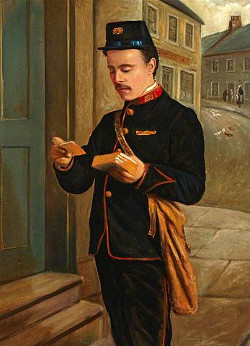
A curious story of two poor lovers, whose system of correspondence was confined to an ingenious cipher of ink-blots on the outside of the letter, is told by the Poet Coleridge. In one of his walks in the Lake district, he saw the postman offer a letter to the servant-girl at a village inn, who, after carefully looking at the address, returned the document to the postman, telling him that she could not take it in, as she was too poor to pay the postage. Thereupon, Coleridge stepped forward, and giving the postman the shilling required for the letter, handed it to the girl. To his surprise, she did not appear as pleased as he had expected; and when the postman was out of hearing, she explained the matter by confessing to the poet that the whole of the letter consisted in its address and certain exterior blots and marks, and that it was the method adopted by her lover and herself to keep up an unpaid-for correspondence in the days of dear postage.
— Thomas Hood, The Book of Modern English Anecdotes, 1872
